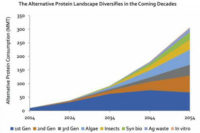While sustainable, insect proteins as a food source face hurdles

Packed with nutrients and considered to be an economically viable alternative to traditional animal proteins, many experts think insect proteins are the food of the future. But convincing westerners to partake faces more hurdles then simply finding a way past the yuck factor, according to researchers with the Global Food Forums, Inc.
As a food source insects are sustainable—able to provide nutrients with relatively low agricultural input. To assess consumer perceptions on this topic, researchers at Global Food Forums, Inc. conducted an R&D Protein Trends Survey among food technologists attending its third annual Protein Trends & Technologies Seminar in May 2015.
During the seminar food technologists were given the opportunity to taste cricket protein flour. At the end of the event, they completed a survey to assess cricket protein on eight factors that could be barriers to its use in foods, on a scale ranging from 1 (insignificant barrier) to 10 (maximum barrier).
According to researchers, the technologists rated the cricket protein flour with a total barrier score of 6.34; those that had not tried the powder responded with an even higher barrier score of 7.74. Tasters rated the cricket protein flour more acceptable on all eight factors than non-tasters.
Consumer acceptance was the highest barrier, though this was closely followed by taste, allergenicity and cost.
“We included the food safety issue of ‘allergenicity’ in the survey; however, many food formulators in the food industry have expressed additional concerns to us, such as the likelihood of various types of contamination, batch-to-batch inconsistency and other QC issues that must be dealt with by large scale commercial suppliers,” said Claudia O'Donnell, co-owner, Global Food Forums, Inc.
“The first most significant contribution of insects to Western diets is most likely to be first as animal feed,” O’Donnell added. “We agree with a 2013 Food and Agricultural Organization (FAO) paper promoting the development of insects for human food. It suggested consumer products will remain a ‘niche market’ for at least another generation in the West and interest will be confined to immigrants and novelty-seekers.”
For more information on trends, statistics, technologies and formulation insights for the protein ingredient industry, see http://globalfoodforums.com/proteinseminar.
Looking for a reprint of this article?
From high-res PDFs to custom plaques, order your copy today!







